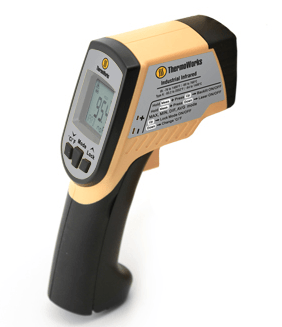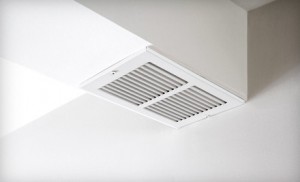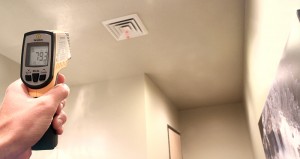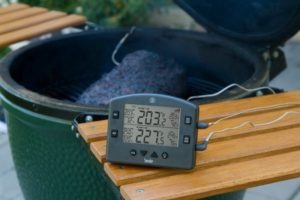Temperature Tools and Tips to Help You Beat the Heat
When summer temperatures soar, and the comfort of your own home offers no comfort at all, many of us look to our air conditioners for answers. But when central air doesn’t seem like it’s getting the job done, an infrared thermometer, combined with these temperature tips might be just what you need to survive a heat wave.
Tools
Infrared thermometers (like the IR-IND) are great – in that – they have the capacity for quick and accurate assessments of hot and cool zones throughout the house, and can cue you in on what your A/C is (or is not) doing.

With a quick point and shoot, the IR-IND can give you accurate temps of your air intake vent, your diffuser vent (where cool air escapes), and surrounding walls. In a matter of seconds, an infrared thermometer can give you a good indication of what’s happening with your central cooling system.
The IR-IND infrared thermometer has an optic range of 30:1, which means that at 30 inches, the spot size for measurement is 1 inch. At 60 inches, the spot size is 2 inches – and so on. Plus, the IR-IND has laser indicators that show you your spot size. Other IR guns require a much closer thermometer-to-target ratio, which means they’re not as effective at reaching out-of-the-way air vents.
When taking temperatures with an infrared thermometer, avoid areas that are directly influenced by heating elements or lights. The warmth from these fixtures can distort otherwise accurate temperature measurements.
What to look for when taking temperatures
According to industry experts, the ambient temperature in your home (without A/C) is roughly 20° cooler than the outside temperature. When it is 100°F outside, the ambient temperature inside will typically be about 80°F. That means the air being taken in by your A/C unit will be at, or near 80°F (or 20° cooler than the outside temperature.) Locate your intake vent, and using an infrared thermometer, aim at the vent and shoot. You’ll instantly know whether or not the air entering your A/C unit is acceptable. If the temperature is higher that -20° vs. outside temp, look for areas where air may be getting in and heating the house.


Scanning the wall will show further increases in heat as the cooler air mingles with warmer air. Increases here should be expected, however too drastic a change in ambient temperature (+76°F) may be an indication that your vents are exhibiting what’s called, surface effect.
Surface effect means air is clinging to the ceiling, floor, wall, reducing throw and velocity. Changing out the vent cover to an adjustable vane “throw” will get the air away from the surface where it can mix and throw to the outside walls.
Assuming your A/C is fully operational, you’ve adjusted the vent, and you’re still fighting a losing battle with Mother Nature, consider these six easy temperature saving tips:
Maintenance is Key
Change the filter on your A/C regularly. Carrier® recommends changing the filter every 30-45 days to ensure proper air flow through the system. If you’ve check the vents with an IR, diverted air flow with an adjustable vane “throw” vent cover, and you’re still too hot. Check the filter!
Lights Out!
When mercury levels are at their highest, keep doors closed and draw the shades. Resist the urge to let in light. Block out the sun, turn off lights that are not in use, and make sure all doors are closed. It may get a little dark, but you’ll be surprised at how much cooler your house will stay.
Save the Chores for Later
Avoid running the dryer, dishwasher, or oven during the day. Each appliance is responsible for 
some time in the early morning, or evening when temperatures aren’t so extreme. And, when it comes to using the oven, try cooking outdoors instead. With the new Smoke you can remotely monitor your grill and food temps from the comfort of your couch.
The Early Bird Stays Cool
The hotter the air circulating into the air conditioner, the warmer the air coming out of the cold air escape. Adjust your thermostat to your ideal daytime temperature early, before the ambient temperature has a chance to get too hot. As the ambient temperature of the home cools, the colder the air coming out of the vents will be.
Keep Those Vents Open*
According to HVAC Expert Colin Martodam, modern forced air and heating systems operate on a balanced pressure load throughout the house. Blocking a vent can impact how the system inhales and exhales air. In other words, it can throw the system out of balance causing it to have to work harder. Shutting off air flow in rooms can eventually ruin the compressor, resulting in costly repairs, or worse – a broken A/C.
Use Ceiling Fans*
Use ceiling fans to increase comfort levels at higher thermostat settings. The standard human comfort range for light clothing in the summer is between 72° and 78°F. To extend the comfort range to 82°F, you need a breeze of about 2.5 ft/sec or 1.7 mph. A slow-turning, ceiling-mounted paddle fan can easily provide this air flow.
Of course if you’re not satisfied with the air flow in the house, you might consider a more sophisticated approach to tracking temperatures. With the RT8100MAT you can track daily high and low temperatures (with a time stamp) in specific locations in the house. This is perfect for monitoring the kid’s rooms for comfort, or keeping tabs on other areas you suspect are letting in a warm draft. You can even set alarms to notify you when a room has gotten too hot.
___________________________
*Keep Those Vents Open. Martodam, Colin. “Myths vs. Facts: Healing, Ventilation and Air Conditioning Myths Decoded.” PowayPatch. (July, 2013). http://poway.patch.com/groups/announcements/p/an–myths-vs-facts-heating-ventilation-and-air-condit7b8681a6d2
*Use Ceiling Fans. Bond. Annie B. “23 Tips for Keeping the House Cool.” Care2 make a difference. (July, 2013). http://www.care2.com/greenliving/keep-house-cool-23-tips.html


